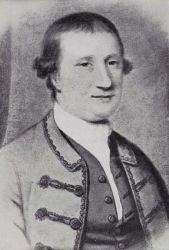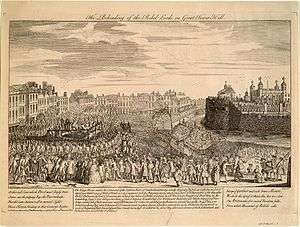Sir John Wedderburn, 5th Baronet of Blackness
Sir John Wedderburn, 5th Baronet of Blackness, was a Perthshire gentleman who joined the 1745 rebellion of Charles Edward Stuart. He was captured at the Battle of Culloden, taken to London, and convicted of treason. He was hanged, his estates were forfeit to the Crown, and his family was attainted. The Blackness in his title is Blackness House in Dundee[1] rather than Blackness in Lothian just west of Edinburgh. His son John Wedderburn of Ballendean fled after his father's death to Jamaica, where he re-established the family's fortunes via slave sugar, and eventually regained his father's title.
Sir John Wedderburn | |
|---|---|
 | |
| Born | |
| Died | 28 November 1746 |
| Nationality | Scottish |
| Occupation | landowner |
| Known for | The "Forty Five" |
Early life
Wedderburn was the son of Alexander Wedderburn, the 4th Baronet, "who had been deposed from his office as Clerk of Dundee in 1717 for supporting the Stuarts in the previous uprising of 1715."[2]
John Wedderburn had a sister, Elizabeth, who married Alexander Read of Logie, Dundee in 1715;[3] their daughter Catherine Read was a noted portrait painter[4] and their son Alexander Read was the grandfather of "Bold" Webster, husband of Frances Annesley, and friend of Lord Byron.[5]
Wedderburn's expectations of an inheritance were not fulfilled, and he fell on hard times. He raised his nine children in "a small farm with a thatched house and a clay floor, which he occupied with great industry, and thereby made a laborious but starving shift to support nine children who used to run about in the fields barefoot".[6]
The "Forty Five"

In 1745 Sir John joined the rebellion of Charles Edward Stuart against the Hanoverian Crown,[7] serving as a colonel in the Jacobite army before being captured at the Battle of Culloden and hauled off to London to face trial and execution.[7] He was indicted for treason at St Margaret's Hill, Southwark on 4 November 1746, and was found guilty, despite arguing in his defence that he had not personally taken up arms against the Crown, and was executed at Kennington Common on 28 November 1746.[6]
Marriage and descendants
According to the genealogist Joseph Foster, Sir John married in 1724 Jean Fullerton, who lived till 1766. Foster only records details of two sons, John and James.[8] He also had daughters, for they are recorded as having been taken in charge by the aforementioned Catherine Read, the portrait painter, after his execution.[9]
- John Wedderburn of Ballendean, 6th Baronet of Blackness (1729–1803), was Wedderburn's eldest son. After the failure of the '45, he made his way to London to plead with such friends as his family still had for his father's rescue and pardon. The boy's mission failed, and he had to witness his father's execution as a traitor by hanging, drawing and quartering. He returned to Scotland, but, with limited prospects there, decided to try for a new life in the New World. In Glasgow he found a ship's captain prepared to let him work his passage on a ship bound for the Caribbean.[7] He spent many years as a planter in Jamaica, returning to Britain a wealthy man, enriched by slave sugar. He brought back with him a slave named Joseph Knight, who took him to court in a freedom suit which set a precedent in Scots law. Eventually John Wedderburn climbed back up the social scale, and his daughter Louisa married General John Hope, 4th Earl of Hopetoun.
- James Wedderburn was Wedderburn's second son. He also went to Jamaica, and there apparently fathered Robert Wedderburn by one of his slaves . Following Robert's rejection by his father's family, he wrote The Horrors of Slavery, which was circulated by the abolitionist movement.[10] A descendant of Robert was Bill Wedderburn, Baron Wedderburn of Charlton (1927-2012).[11] James's children by his wife, Hon. Mary Louisa Eden, fifth daughter of William Eden, 1st Baron Auckland, include Andrew Colvile, governor of the Hudson's Bay Company; Jean, who married Thomas Douglas, 5th Earl of Selkirk; and James Wedderburn, Solicitor General for Scotland until his death in 1822.[12] The other surviving son was Peter Wedderburn Ogilvy, who became a sea captain[13]
References
- Oliver, Neil, A History of Scotland, Phoenix, London (2010) ISBN 0753826631
- Rothschild, Emma, The Inner Life of Empires: An Eighteenth-Century History Retrieved June 2012
Notes
- Baxter, Kenneth; Whatley,, Patricia; McKean,, Charles (2013). Lost Dundee : Dundee's Lost Architectural Heritage. Birlinn. ISBN 9781780271064.
|access-date=requires|url=(help)CS1 maint: extra punctuation (link) - "FDCA - Sir John Wedderburn". www.fdca.org.uk. Retrieved 4 May 2018.
- Elliot, Alexander (1911). "7". "Lochee" - As it was and is. Retrieved 4 May 2018.
- O'Donoghue, Freeman Marius (1896). "Read, Catherine". In Lee, Sidney (ed.). Dictionary of National Biography. 47. London: Smith, Elder & Co.
- Stewart, John (2008). "2". Byron and the Websters : the letters and entangled lives of the poet, Sir James Webster and Lady Frances Webster. Jefferson, N.C.: McFarland & Co. ISBN 9780786432400.
- Cobbett, William, p.429 Cobbett's Complete Collection of State Trials and Proceedings, Volume 18 Retrieved June 2012
- Oliver, p.326
- Foster, Joseph. textsThe peerage, baronetage, and knightage of the British Empire : for 1882 (1883 ed.). Nicols & Sons. p. 646.
- Miss Katherine Read, Court Paintress, A. Francis Steuart, The Scottish Historical Review, Vol. 2, No. 5 (Oct., 1904), pp. 38-46 (abstract)
- {{Malcolm Chase, ‘Wedderburn, Robert (1762–1835/6?)’, Oxford Dictionary of National Biography, Oxford University Press, 2004; online edn, May 2008 accessed 17 Oct 2016}}
- McCarthy, Bill (12 March 2012). "Obituary". The Guardian. Retrieved 19 October 2016.
- The Gentleman's Magazine (Volume 92, Part 2 ed.). 1822. p. 479.
- Legacies of British Slave-ownership. Peter Wedderburn Ogilvy (23rd Sep 1781 - 30th Mar 1873)
External links
- Account of the Trial and Execution of the 5th Baronet Retrieved June 2012